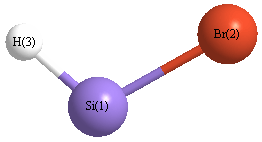Vibrational Frequencies calculated at B2PLYP=FULL/6-31+G**
| Mode Number |
Symmetry |
Frequency
(cm-1) |
Scaled Frequency
(cm-1) |
IR Intensities
(km mol-1) |
Raman Act
(Å4/u) |
Dep P |
Dep U |
|---|
| 1 |
A' |
2095 |
1992 |
311.00 |
214.70 |
0.49 |
0.66 |
| 2 |
A' |
792 |
754 |
60.89 |
12.15 |
0.71 |
0.83 |
| 3 |
A' |
414 |
394 |
76.08 |
24.30 |
0.29 |
0.45 |
Unscaled Zero Point Vibrational Energy (zpe) 1650.6 cm
-1
Scaled (by 0.951) Zero Point Vibrational Energy (zpe) 1569.7 cm
-1
See section
III.C.1 List or set vibrational scaling factors
to change the scale factors used here.
See section
III.C.2
Calculate a vibrational scaling factor for a given set of molecules
to determine the least squares best scaling factor.
